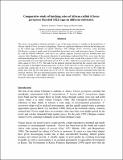| dc.contributor.author | Macharia, Sammy K | |
| dc.contributor.author | Ngugi, Charles C | |
| dc.contributor.author | Rasowo, Joseph | |
| dc.date.accessioned | 2015-11-10T09:24:18Z | |
| dc.date.available | 2015-11-10T09:24:18Z | |
| dc.date.issued | 2004 | |
| dc.identifier.citation | Comparative study of hatching rates of African catfish (Clarias gariepinus Burchell 1822) eggs on different substrates. 1Macharia, Sammy K.,2 Charles C. Ngugi, and 3Rasowo Joseph 1 Ministry of Agriculture. Fisheries Department PO Box 1084 Kisumu. 2 Moi university, Fisheries Department, P.O Box 1125, Eldoret. 3 Moi University, Zoology Department, P O Box 1125, Eldoret | en_US |
| dc.identifier.uri | http://hdl.handle.net/11671/744 | |
| dc.description.abstract | The choice of incubation substrate materials is one of the major factors to consider in the production of
African catfish (Clarias gariepinus) fingerlings. There was significant difference between the hatching rates
of the catfish eggs incubated on natural substrates: Nile cabbage (Pistia stratiotes), water hyacinth
(Eichhornia crassipes), pond weed (Ceratophyllum dermasum) roots, and green grass leaves (Commelina
Sp.) and the artificial substrates: sisal (Agava sp.), plastic, papyrus (Cyperus papyrus), kakaban mats and
concrete slabs. Ranking of the natural substrates by performance indicated that Pistia roots were the best
with mean hatching rate of 66.2 ± 3.62%, the green grass leaves were second with a mean of 54.0 ± 3.46%,
water hyacinth roots were third with mean rate of 49.7 ± 3.16%, while the Ceratophyllum roots were fourth
with a mean of 13.0 ± 2.37%. The ranks for the artificial substrate showed that the concrete slabs tied with
the sisal mats as the highest having mean rates of 18.6 ± 2.8% and 18.6 ± 2.0% respectively, papyrus was
second with a mean rate of 12.2 ± 1.2%, kakaban was third with a mean rate of 11.8 ± 1.9% while the
plastic mats were the last with mean rate of 4.0 ± 0.7%. The natural substrates performed better than the
artificial substrate. The best performing natural substrates were those with floating ability and thin fibrous
roots that seemed to allow higher aeration of the eggs during incubation. There were minimal costs
incurred in the usage of the natural substrates | en_US |
| dc.language.iso | en | en_US |
| dc.publisher | Lake Victoria Environmental Management Project (LVEMP) | en_US |
| dc.subject | Substrate materials | en_US |
| dc.subject | Pond weed | en_US |
| dc.subject | Nile cabbage | en_US |
| dc.subject | Water hyacinth | en_US |
| dc.title | Comparative study of hatching rates of African catfish (Clarias gariepinus Burchell 1822) eggs on different substrates | en_US |
| dc.type | Article | en_US |

